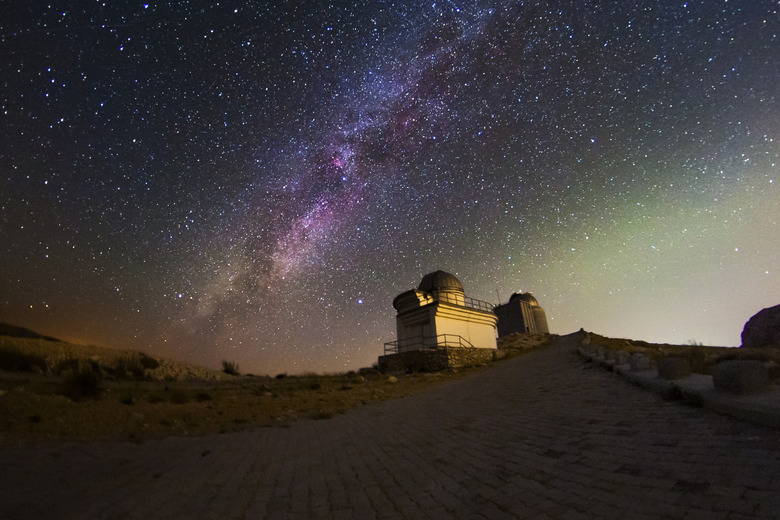What Do Stars Look Like?
What are we actually seeing as stars twinkle in the night sky? These balls of plasma and energy are a window into the past, as light from thousands or millions of years ago reaches our solar system and pierces through Earth's atmosphere. There are multitudes of metrics to measure when we process and perceive star light, and we can use this information to understand how our universe is constantly changing.
The Atmosphere and Light Pollution
The Atmosphere and Light Pollution
Viewing the stars from Earth is a bit like looking through a dirty lens or a foggy street; compared to the emptiness of space, the atmosphere's density heavily obscures the light from stars. Moreover, air is always moving, so starlight appears to be shifting and shimmering, often resulting in the twinkling image we see as light diffracts in through the atmosphere. The atmosphere also makes stars appear dimmer than they would be if we could see them from space.
Even on a perfectly clear night, the atmosphere can still obscure starlight, but another source of significant impedance is light pollution. The bright, densely pack city lights of populated areas can effectively wash out the intensity of light from even the brightest stars. The moon also acts a a form of natural light obfuscation because of it's intense luminosity overshadowing other points of light in the sky.
TL;DR (Too Long; Didn't Read)
Areas that are sufficiently far away from cities and high population areas can be classified as dark sky sites. If you travel to these locations you can see many more stars and even the milky way galaxy!
Stars Have Different Colors
Stars Have Different Colors
If you stop and examine the sky on a dark, moonless night, it's easier to spot color differences among stars. The color of a star is often a visual indication of its surface temperature. The hottest stars are blue, followed by large white stars, yellow stars, red giants, and red dwarf stars. Some red dwarf stars are so dim that we can't see them at all, and some stars, called brown dwarfs, hardly emit any light at all.
TL;DR (Too Long; Didn't Read)
Red stars are the coolest variety of stars, but the sheer size of some of the largest red giants means they can be very bright stars.
There are other remnants of stars like neutron stars and white dwarf stars that are very dim, as they have lost much of their energy through their stellar life cycle. Some star remnants don't emit light – they trap it. These are black holes, the leftovers of hot, giant stars that have exploded as supernovae.
Stars Are Different Sizes
Stars Are Different Sizes
One reason that stars vary in brightness is that hotter stars emit more energy than cooler ones, but another important reason is that some are much bigger than others. For example, Betelgeuse – a star in the constellation Orion – shines with a red light, but it appears bright to us because it's simply huge, but it is much colder than . If it took the place of the sun, its surface would extend to the orbit of Jupiter. White dwarfs, on the other end of the scale, are Earth-sized and quite dim, but they are among the hottest objects in the sky. They are the remnants of dying stars and are often surrounded by a ghostly gas formation known as a planetary nebula.
Classification of Stars
Classification of Stars
Stars have a variety of metrics used to describe how a star looks, the star's temperature, wavelengths of emitted light, luminosity, size, and more. Stars are generally classified as giants, super giants, main sequence stars, or white dwarfs. Each of these categories have different temperature, luminosity, and spectral classifications.
Scientists continue to contribute more data and observations to the study of star formation and their life cycles. Telescopes like the Hubble Space Telescope and NASA's James Webb observe extremely bright stars that are so far away we can't see them otherwise.
Apparent and Absolute Magnitude
Apparent and Absolute Magnitude
Some stars appear brighter to Earthlings simply because they're closer. Astronomers rank the brightness of stars – as seen from Earth – by assigning them a number known as apparent magnitude – the smaller the magnitude, the brighter the object. They have also devised a measure that ranks stars according to how bright they are when compared to each other. This number, called absolute magnitude, describes how bright a star would appear if it were 10 parsecs (about 32.6 light-years) distant. With an apparent magnitude of minus 26.7, the sun is the brightest object in the sky. Its absolute magnitude, however, is only 4.7. If that were its apparent magnitude, it wouldn't even be visible to the naked eye of a person in an urban center.
Cite This Article
MLA
Deziel, Chris. "What Do Stars Look Like?" sciencing.com, https://www.sciencing.com/what-do-stars-look-like-4587447/. 24 July 2023.
APA
Deziel, Chris. (2023, July 24). What Do Stars Look Like?. sciencing.com. Retrieved from https://www.sciencing.com/what-do-stars-look-like-4587447/
Chicago
Deziel, Chris. What Do Stars Look Like? last modified July 24, 2023. https://www.sciencing.com/what-do-stars-look-like-4587447/
